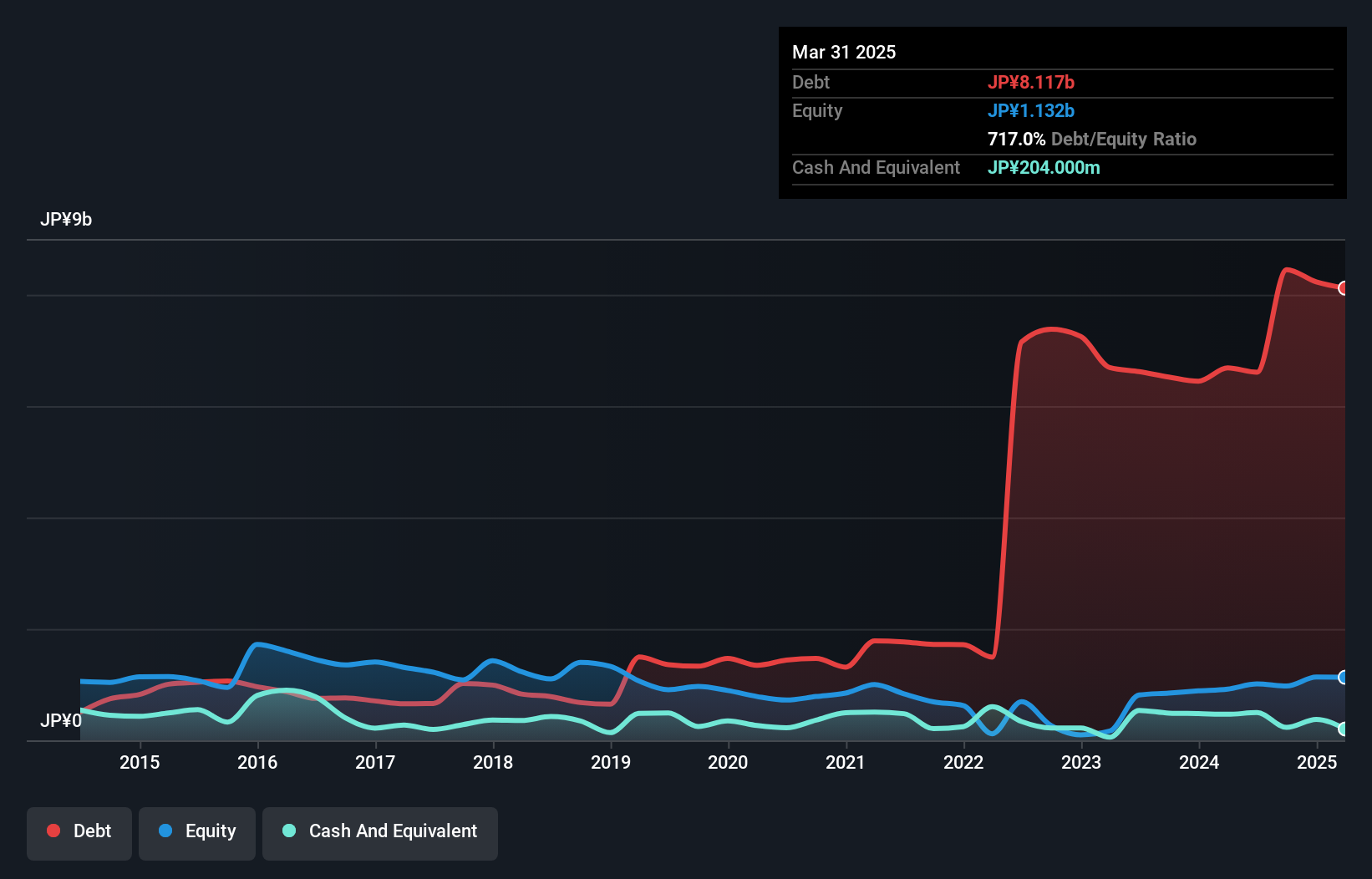David Iben put it well when he said, 'Volatility is not a risk we care about. What we care about is avoiding the permanent loss of capital.' When we think about how risky a company is, we always like to look at its use of debt, since debt overload can lead to ruin. As with many other companies Kimuratan Corporation (TSE:8107) makes use of debt. But the more important question is: how much risk is that debt creating?
When Is Debt Dangerous?
Generally speaking, debt only becomes a real problem when a company can't easily pay it off, either by raising capital or with its own cash flow. Ultimately, if the company can't fulfill its legal obligations to repay debt, shareholders could walk away with nothing. However, a more frequent (but still costly) occurrence is where a company must issue shares at bargain-basement prices, permanently diluting shareholders, just to shore up its balance sheet. By replacing dilution, though, debt can be an extremely good tool for businesses that need capital to invest in growth at high rates of return. When we think about a company's use of debt, we first look at cash and debt together.
What Is Kimuratan's Net Debt?
As you can see below, at the end of March 2025, Kimuratan had JP¥8.12b of debt, up from JP¥6.69b a year ago. Click the image for more detail. However, it does have JP¥204.0m in cash offsetting this, leading to net debt of about JP¥7.91b.

A Look At Kimuratan's Liabilities
The latest balance sheet data shows that Kimuratan had liabilities of JP¥1.33b due within a year, and liabilities of JP¥7.63b falling due after that. Offsetting this, it had JP¥204.0m in cash and JP¥29.0m in receivables that were due within 12 months. So it has liabilities totalling JP¥8.73b more than its cash and near-term receivables, combined.
This deficit is considerable relative to its market capitalization of JP¥13.8b, so it does suggest shareholders should keep an eye on Kimuratan's use of debt. This suggests shareholders would be heavily diluted if the company needed to shore up its balance sheet in a hurry.
Check out our latest analysis for Kimuratan
We use two main ratios to inform us about debt levels relative to earnings. The first is net debt divided by earnings before interest, tax, depreciation, and amortization (EBITDA), while the second is how many times its earnings before interest and tax (EBIT) covers its interest expense (or its interest cover, for short). This way, we consider both the absolute quantum of the debt, as well as the interest rates paid on it.
Kimuratan shareholders face the double whammy of a high net debt to EBITDA ratio (20.6), and fairly weak interest coverage, since EBIT is just 1.4 times the interest expense. The debt burden here is substantial. However, it should be some comfort for shareholders to recall that Kimuratan actually grew its EBIT by a hefty 268%, over the last 12 months. If it can keep walking that path it will be in a position to shed its debt with relative ease. There's no doubt that we learn most about debt from the balance sheet. But you can't view debt in total isolation; since Kimuratan will need earnings to service that debt. So if you're keen to discover more about its earnings, it might be worth checking out this graph of its long term earnings trend.
Finally, a business needs free cash flow to pay off debt; accounting profits just don't cut it. So we clearly need to look at whether that EBIT is leading to corresponding free cash flow. Over the last two years, Kimuratan actually produced more free cash flow than EBIT. There's nothing better than incoming cash when it comes to staying in your lenders' good graces.

Our View
We weren't impressed with Kimuratan's interest cover, and its net debt to EBITDA made us cautious. But like a ballerina ending on a perfect pirouette, it has not trouble converting EBIT to free cash flow. Considering this range of data points, we think Kimuratan is in a good position to manage its debt levels. Having said that, the load is sufficiently heavy that we would recommend any shareholders keep a close eye on it. When analysing debt levels, the balance sheet is the obvious place to start. However, not all investment risk resides within the balance sheet - far from it. For example Kimuratan has 2 warning signs (and 1 which is a bit unpleasant) we think you should know about.
At the end of the day, it's often better to focus on companies that are free from net debt. You can access our special list of such companies (all with a track record of profit growth). It's free.
Valuation is complex, but we're here to simplify it.
Discover if Kimuratan might be undervalued or overvalued with our detailed analysis, featuring fair value estimates, potential risks, dividends, insider trades, and its financial condition.
Access Free AnalysisHave feedback on this article? Concerned about the content? Get in touch with us directly. Alternatively, email editorial-team (at) simplywallst.com.
This article by Simply Wall St is general in nature. We provide commentary based on historical data and analyst forecasts only using an unbiased methodology and our articles are not intended to be financial advice. It does not constitute a recommendation to buy or sell any stock, and does not take account of your objectives, or your financial situation. We aim to bring you long-term focused analysis driven by fundamental data. Note that our analysis may not factor in the latest price-sensitive company announcements or qualitative material. Simply Wall St has no position in any stocks mentioned.
About TSE:8107
Kimuratan
Plans, produces, and sells baby and children’s clothing in Japan.
Mediocre balance sheet with very low risk.
Market Insights
Community Narratives




